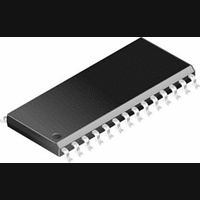PIC14000-04I/SS Microchip Technology, PIC14000-04I/SS Datasheet - Page 57

PIC14000-04I/SS
Manufacturer Part Number
PIC14000-04I/SS
Description
IC, 8BIT MCU, PIC14, 4MHZ, SSOP-28
Manufacturer
Microchip Technology
Datasheet
1.PIC14000-04SO.pdf
(153 pages)
Specifications of PIC14000-04I/SS
Controller Family/series
PIC14
No. Of I/o's
22
Ram Memory Size
192Byte
Cpu Speed
4MHz
No. Of Timers
2
Interface
I2C
Digital Ic Case Style
SSOP
Core Size
8 Bit
Program Memory Size
4096 X 14
Embedded Interface Type
I2C
Rohs Compliant
Yes
Processor Series
PIC14000
Core
PIC
Data Bus Width
8 bit
Program Memory Type
EPROM
Data Ram Size
192 B
Interface Type
SPI, UART
Maximum Clock Frequency
20 MHz
Number Of Programmable I/os
22
Number Of Timers
1
Operating Supply Voltage
2.7 V to 6 V
Maximum Operating Temperature
+ 85 C
Mounting Style
SMD/SMT
Package / Case
SSOP-28
Development Tools By Supplier
ICE2000
Minimum Operating Temperature
- 40 C
On-chip Adc
14 bit
Lead Free Status / RoHS Status
Lead free / RoHS Compliant
8.0
8.1
The PIC14000 includes analog components to create a
slope A/D converter including:
• Comparator
• 4-bit programmable current source
• 16-channel analog mux
• 16-bit timer with capture register
Each channel is converted independently by means of
a slope conversion method using a single precision
comparator. The programmable current source feeds
an external 0.1 F (nominal) capacitor to generate the
ramp voltage used in the conversion.
8.2
These are the steps to perform data conversion:
• Clear REFOFF (SLPCON<5>) and ADOFF
• Initialize ADCON1<7:4> to initialize the program-
• Set ADRST (ADCON0<1>), for a minimum of 200
• The A/D timer (ADTMR) increments from 0000h
• To start a conversion, clear ADRST through soft-
• When the ramp voltage exceeds the analog input,
• This transition causes a capture event and copies
• An interrupt is generated to the CPU if enabled.
1996 Microchip Technology Inc.
(SLPCON<0>) bits to enable the A/D module.
mable current source.
capacitor to ground.
to FFFFh and must be initialized before each con-
version.
ware, it will allow the timer to begin counting and
the ramp capacitor to begin charging.
the comparator output changes from high to low.
the current A/D timer value into the 16-bit capture
register.
Note:
s to stop the timer and fully discharge the ramp
ANALOG MODULES FOR A/D
CONVERSION
Overview
Conversion Process
The A/D timer continues to run following a
capture event.
This document was created with FrameMaker 4 0 4
Preliminary
The maximum A/D timer count is 65,536. It can be
clocked by the on-chip or external oscillator. At a 4 MHz
oscillation frequency, the maximum conversion time is
16.38 ms for a full count. A typical conversion should
complete before full-count is reached. A timer overflow
flag is set once the timer rolls over (FFFFh to 0000h),
and an interrupt is sent to the CPU, if enabled.
End-user calibration is simplified or eliminated by mak-
ing use of the on-chip EPROM. Internal component val-
ues are measured at factory final test and stored in the
memory for use by the application firmware.
Periodic conversion cycles should be performed on the
bandgap
Section 9.0) to compensate for A/D component drift.
Measurements for the reference voltage count are
equated to the voltage value stored into EPROM during
calibration. All other channel measurements are
compensated for by ratioing the actual count with the
bandgap count and multiplying by the bandgap voltage
value stored in EPROM. Since all measurements are
relative to the reference, offset voltages inherent in the
comparator are cancelled out. See AN624, “PIC14000
A/D Theory and Implementation” for further details of
A/D operation.
The analog components used in the conversion and
the A/D timer can be disabled during idle periods for
maximum power savings. Power-saving can be
achieved via software and/or hardware control
(Section 10.8).
8.3
The A/D timer (ADTMR) is comprised of a 16-bit up
timer, which is incremented every oscillator cycle.
ADTMR is reset to 0000h by a power-up reset; other-
wise the software must initialize it after each conver-
sion. A separate 16-bit capture register (ADCAP) is
used to capture the ADTMR count if an A/D capture
event occurs (see below). Both the A/D timer and cap-
ture register are readable and writable. The low byte of
the A/D timer (ADTMRL) is accessed at location 0Eh
while the high byte (ADTMRH) is accessed at location
0Fh. Similarly, the low byte of the A/D capture register
(ADCAP) is accessed at location 15h, and the high byte
is located at 16h.
A/D Timer (ADTMR) Module
and
slope
references
PIC14000
DS40122B-page 57
(described
in
















